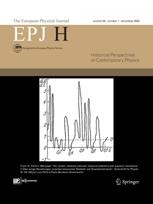Traveling-wave tubes: The unsung heroes of space exploration
An invention from the 1950s is still being used today
New York | Heidelberg, 27 March 2019
 What do televisions and space exploration have in common? No, we’re not talking about a cheesy physics joke; rather, this is the story of an often-overlooked piece of equipment that deserves a place in the annals of telecommunication history. Some would argue that the traveling-wave tube (TWT) has not received the recognition it deserves when it comes to the history of space travel and communications – until now. A group of researchers based at the Aix-Marseille Université in France has published a review looking into the history of TWTs, recently published in EPJ H.
What do televisions and space exploration have in common? No, we’re not talking about a cheesy physics joke; rather, this is the story of an often-overlooked piece of equipment that deserves a place in the annals of telecommunication history. Some would argue that the traveling-wave tube (TWT) has not received the recognition it deserves when it comes to the history of space travel and communications – until now. A group of researchers based at the Aix-Marseille Université in France has published a review looking into the history of TWTs, recently published in EPJ H.
This is the first time a paper aimed at the general public has described the vital role of this technology in various areas of development. The team collected and read hundreds of papers on the history and evolution of the traveling-wave tube. First introduced in the 1950s, a TWT is a relatively simple piece of equipment used for transmitting data across long distances, including the vast expanses of space.
A TWT is made up of three parts – an electron gun that produces the beam; a slow wave structure made up of a series of magnets, through which the beam travels; and a collector that limits the amount of energy lost in the process. The paper describes how the TWT was pivotal to the development of the television in the 1950s, and to the space programme in the 1960s.
But it is just as relevant today. “Traveling-wave tubes are still frequently used in space telecommunication and for deep-space missions,” says Damien Minenna, a PhD student who worked on the paper. For example, the NASA probe New Horizons recently sent images of Kuiper belt objects, the most distant images from Earth ever taken by a spacecraft, and they were transmitted using a TWT.
In Minenna’s own research, he uses TWTs to study chaos in plasmas. He hopes the review article will help others understand, and appreciate, the importance and history of the traveling-wave tube.
References: D.F.G. Minenna, F. Andre, Y. Elskens, J.F. Auboin, F. Doveil, J. Puech and E. Duverdier (2019), The Traveling-Wave Tube in the History of Telecommunication, European Physical Journal H, DOI 10.1140/epjh/e2018-90023-1
Further Information
For more information visit: www.epj.org
Services for Journalists
The full-text article is available here.
Contact
Sabine Lehr | Springer | Physics Editorial Department
tel +49-6221-487-8336 | sabine.lehr@springer.com
